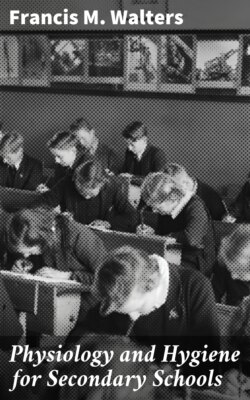Читать книгу Physiology and Hygiene for Secondary Schools - Francis M. Walters - Страница 16
На сайте Литреса книга снята с продажи.
PRACTICAL WORK
ОглавлениеTable of Contents
Examine a dissectible model of the chest and its contents (Fig. 49). Note the relative size of the two lungs and their position with reference to the heart and diaphragm. Compare the side to side and vertical diameters of the cavity. Trace the air tubes from the trachea to their smallest divisions.
Observation of Lungs (Optional).—Secure from a butcher the lungs of a sheep, calf, or hog. The windpipe and heart should be left attached and the specimen kept in a moist condition until used. Demonstrate the trachea, bronchi, and the bronchial tubes, and the general arrangement of pulmonary arteries and veins. Examine the pleura and show lightness of lung tissue by floating a piece on water.
To show the Changes that Air undergoes in the Lungs.—1. Fill a quart jar even full of water. Place a piece of cardboard over its mouth and invert, without spilling, in a pan of water. Inserting a tube under the jar, blow into it air that has been held as long as possible in the lungs. When filled with air, remove the jar from the pan, keeping the top well covered. Slipping the cover slightly to one side, insert a burning splinter and observe that the flame is extinguished. This proves the absence of sufficient oxygen to support combustion. Pour in a little limewater43 and shake to mix with the air. The change of the limewater to a milky white color proves the presence of carbon dioxide.
Fig. 50—Apparatus for showing changes which air undergoes while in the lungs.
2. The effects illustrated in experiment 1 may be shown in a somewhat more striking manner as follows: Fill two bottles of the same[pg 102] size each one fourth full of limewater and fit each with a two-holed rubber stopper (Fig. 50). Fit into each stopper one short and one long glass tube, the long tube extending below the limewater. Connect the short tube of one bottle and the long tube of the other bottle with a Y-tube. Now breathe slowly three or four times through the Y-tube. It will be found that the inspired air passes through one bottle and the expired air through the other. Compare the effect upon the limewater in the two bottles. Insert a small burning splinter into the top of each bottle and note result. What differences between inspired and expired air are thus shown?
3. Blow the breath against a cold window pane. Note and account for the collection of moisture.
4. Note the temperature of the room as shown by a thermometer. Now breathe several times upon the bulb, noting the rise in the mercury. What does this experiment show the body to be losing through the breath?
To show Changes in the Thoracic Cavity.—1. To a yard- or meter-stick, attach two vertical strips, each about eight inches long, as shown in Fig. 51. The piece at the end should be secured firmly in place by screws or nails. The other should be movable. With this contrivance measure the sideward and forward expansion of a boy's thorax. Take the diameter first during a complete inspiration and then during a complete expiration, reading the difference. Compare the forward with the sideward expansion.
Fig. 51—Apparatus for measuring chest expansion.
2. With a tape-line take the circumference of the chest when all the air possible has been expelled from the lungs. Take it again when the lungs have been fully inflated. The difference is now read as the chest expansion.
Fig. 52—Simple apparatus for illustrating the action of the diaphragm.
To illustrate the Action of the Diaphragm.—Remove the bottom from a large bottle having a small neck. (Scratch a deep mark with a[pg 103] file and hold on the end of this mark a hot poker. When the glass cracks, lead the crack around the bottle by heating about one half inch in advance of it.) Place the bottle in a large glass jar filled two thirds full of water (Fig. 52). Let the space above the water represent the chest cavity and the water surface represent the diaphragm. Raise the bottle, noting that the water falls, thereby increasing the space and causing air to enter. Then lower the bottle, noting the opposite effect. To show the movement of the air in and out of the bottle, hold with the hand (or arrange a support for) a burning splinter over the mouth of the bottle.
To estimate the Capacity of the Lungs.—Breathing as naturally as possible, expel the air into a spirometer (lung tester) during a period, say of ten respirations (Fig. 53). Note the total amount of air exhaled and the number of "breaths" and calculate the amount of air exhaled at each breath. This is called the tidal air.
Fig. 53—Apparatus (spirometer) for measuring the capacity of the lungs.
2. After an ordinary inspiration empty the lungs as completely as possible into the spirometer, noting the quantity exhaled. This amount, less the tidal air, is known as the reserve air. The air which is now left in the lungs is called the residual air. On the theory that this is equal in amount to the reserve air, calculate the capacity of the lungs in an ordinary inspiration.
3. Now fill the lungs to the full expansion of the chest and empty them as completely as possible into the spirometer, noting the amount expelled. This, less the tidal air and the reserve air, is called the complemental air. Now calculate the total capacity of the lungs.
